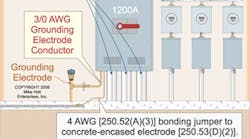All Code references are based on the 2005 NEC. The grounding and bonding requirements in this column apply to solidly grounded systems that operate at not more than 600V, such as 120/240V, 120/208V, and 277/480V.
Part 6 of this series on grounding and bonding discussed grounding electrode systems and compared them to the tires on race cars. This month's subject is the grounding electrode conductor (GEC), which you can think of as the suspension in a car. A properly tuned suspension allows the tires to do their job and keep the car on the track. Similarly, the GEC connects the equipment grounding conductor and the grounded (neutral) conductor to the grounding electrode system.
The GEC performs this function at the service, at each building or structure (where supplied by a feeder), or at the source of a separately derived system (Art. 100). The GEC can be solid or stranded, insulated or bare. In most cases, it must be copper, but you can use aluminum if the GEC isn't subjected to corrosive conditions and isn't within 18 inches of the earth [250.64(A)].
The NEC doesn't require you to identify the GEC, but the generally accepted practice is to apply green marking tape, strip off a few extra inches of insulation (if used), or not identify the GEC at all.
Size matters. Using Table 250.66, size the GEC for the largest service-entrance conductor (or equivalent area for parallel conductors), unless the GEC connects to one of the three following electrode types:
-
Ground rod — That portion of the GEC that's the sole connection to the ground rod doesn't need to be larger than 6 AWG copper. Follow the ground rod installation requirements contained in 250.52(A)(5).
-
Concrete-encased grounding electrode (Ufer ground) — That portion of the GEC that's the sole connection to the concrete-encased electrode doesn't need to be larger than 4 AWG copper. Follow the concrete-encased electrode installation requirements contained in 250.52(A)(3).
-
Ground ring [250.52(A)(4)] — That portion of the GEC that's the sole connection to the ground ring doesn't need to be larger than the conductor used for the ground ring. A ground ring that encircles the building or structure in direct contact with the earth must consist of no less than 20 feet of bare copper conductor not smaller than 2 AWG.
So as you can see, sizing the GEC is simpler than it might seem. Prove this to yourself by answering this question.
Q. What size GEC do you need for a 1,200A service supplied by three parallel sets of 600 kcmil copper conductors per phase (Fig. 1)?
A. The equivalent area of three parallel 600 kcmil conductors is 1,800 kcmil. So look in the far left column of Table 250.66 for the row that pertains to an 1,800 kcmil conductor. You can see that the last row, “Over 1100,” is the one you want. The GEC size denoted by that row is 3/0 AWG.
Note that where a water pipe is used as the grounding electrode as shown in Fig. 1, a supplemental electrode is required [250.53(D)(2)]. In this example, the concrete-encased electrode is the supplemental electrode and 4 AWG is the minimum bonding jumper required [250.66(B)].
Installing the GEC. If your GEC runs across a surface (or behind panels that allow access), the NEC considers it “exposed” (Art. 100), and 250.64(B) requires you to provide protection against physical damage. The first step in providing protection is to securely fasten the GEC to the surface on which it runs. Any additional steps will depend on its size. If the GEC is:
-
4 AWG or larger, you must protect it from physical damage [250.64(B)].
-
6 AWG and free from exposure to physical damage, you can run it along the surface of the building construction without metal covering. If a 6 AWG GEC is exposed to physical damage, you must run it in rigid metal conduit (RMC), intermediate metal conduit (IMC), rigid nonmetallic conduit (RNC), electrical metallic tubing (EMT), or cable armor.
-
Smaller than 6 AWG, you must run it in RMC, IMC, RNC, EMT, or cable armor.
If you install the GEC in a ferrous metal raceway, you must make that raceway electrically continuous by bonding each end of the raceway to the GEC [250.64(E)].
Splices. You can run the GEC to any convenient grounding electrode [250.64(F)]. But what if your GEC isn't long enough to reach? Can you splice it? Yes, but only if you use one of the methods provided in 250.64(C):
-
Use compression-type connectors listed for grounding, or exothermically weld the splice.
-
If needed, connect sections of busbars together to form a GEC.
-
Terminate the GEC to a busbar sized not smaller than ¼ inch by 2 inches. Fasten the GEC securely in place at an accessible location. Make connections exothermically or with listed connectors (Fig. 2).
Taps. When a service consists of multiple disconnecting means as permitted in 230.71(A), you can use a grounding electrode tap from each disconnect to a common GEC [250.64(D)]. You must size the grounding electrode tap from each disconnect to the largest ungrounded conductor serving that disconnect per 250.66.
Size the common GEC for the grounding electrode taps per 250.66. However, take note that you must base its size on the service conductors that feed all the service disconnects (Fig. 3).
Each grounding electrode tap must terminate to the common GEC in such a manner that the common GEC will be free of splices and joints. In addition, the grounding electrode tap can't be made within the service-disconnect enclosure.
Enclosures. Each end of ferrous (iron/steel) raceways, boxes, and enclosures that contain the GECs must be bonded to the GEC [250.92(A)(3)]. On the other hand, nonferrous metal raceways, such as aluminum RMC that enclose the GEC, don't need to be bonded to the GEC.
If you use a bonding jumper with a bonding bushing or wedge [250.92(B)(4)] to bond the raceway to the GEC, you must size the bonding jumper no smaller than the enclosed GEC (Fig. 4).
The terminator. How should you terminate your GEC to grounding electrodes? In all but the following two situations you must start by ensuring the GEC attachment fitting remains accessible [250.68(A)]:
-
The grounding electrode attachment fitting to an encased or buried grounding electrode isn't required to be accessible.
-
An exothermic or compression connection to fireproofed structural metal isn't required to be accessible.
The second rule is to make the connection to the GEC in a manner that ensures a permanent and effective grounding path. If you have an underground metal water pipe electrode, you must install a bonding jumper around insulated joints and equipment likely to be disconnected for repairs or replacement [250.68(A)].
Continuity of the conductive bonding path for metal water piping as required by 250.104(A) can't rely on water meters, filtering devices, or similar equipment [250.53(D)(1)].
The GEC must terminate to the grounding electrode by exothermic welding, listed lugs, listed pressure connectors, listed clamps, or other listed means. In addition, termination fittings must be listed for the materials of the grounding electrode. You can't terminate more than one conductor on a single clamp or fitting unless the clamp or fitting is listed for multiple connections (250.70).
When the termination to a grounding electrode is encased in concrete or buried, the termination fitting must be listed and identified for this purpose. Ground fittings listed for concrete encasement or direct burial are typically made from brass or bronze, not steel or aluminum alloy, so pay attention to the color of the fittings to reduce errors in the field.
You're now well equipped to avoid mistakes in your GEC installations. You should be able to ensure correct sizing, adequate protection, and proper termination. Now your grounding system won't skid off the track because of GEC errors.




